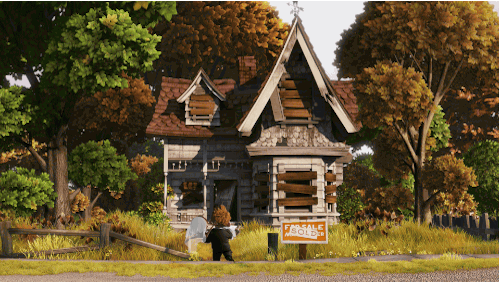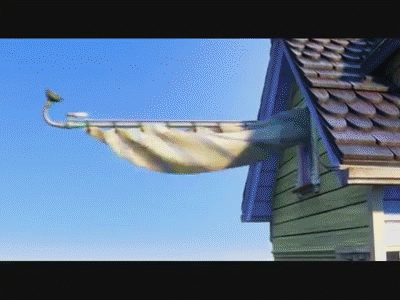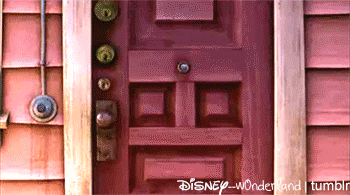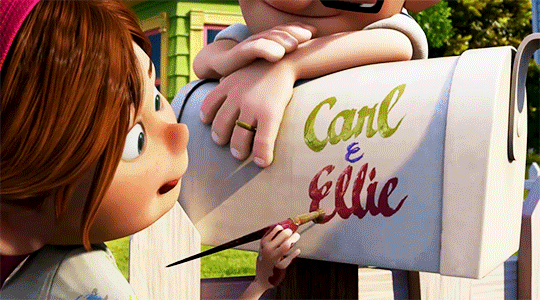What's UP with the NRHP?
- TerraX Team
- Sep 15, 2023
- 12 min read
Good AFteRnoon, our name is TerraXplorations and we are archaeological, historic, and architectural Xplorers! Are you in need of any Cultural Resources Management today?

As your TerraX troop leaders, we are going to help our junior Xplorers finally break down the United States National Register of Historic Places (NRHP)! (AKA, the official list of the nation's historic places considered worthy of preservation as authorized by the National Historic Preservation Act of 1966). Don’t worry! We know it sounds daunting. To make it easy on all of us, we are using Carl and Ellie Fredricksen’s refurbished Victorian style, balloon-flying house from Pixar’s, UP!

Like Russell showing up on Mr. Fredricksen’s porch, we asked our Lead Architectural Historian, Briane Shane, to use her expertise and senior status to help us earn our badge in the NRHP eligibility process, and in addition, tell us if Carl’s colorful flying house is eligible for NRHP inclusion.
Let’s add the Fredricksen home to the NRHP!

The 50-Year Rule
First and foremost, when evaluating a historic resource it must be more than 50 years or older, generally. (You gotta keep these documents up to date!) This can get complicated, but it’s the best place to start when evaluating a resource. In looking at our colorful fictitious example, Briane says, “I think it is safe to assume Carl’s house meets the 50-year rule, considering the time Carl and his wife spent together before and after they bought the house.”
We did some fact checking and discovered that Ellie and Carl actually met in the 1930s at what they called their clubhouse (AKA the same house they lived in and Carl attached 20,000 balloons to). From evidence of boarded up windows and original wood craftsmanship, the house was already quite old even before the two had met. So, by the time the two had bought the house they once called their clubhouse, the home was most certainly 50 years old, potentially even older! (Slide through photos to see what we mean.)
Now that we have confirmed the basics, let’s get into what aspects of Carl’s house could actually be considered a historic resource.
Five Types of Historic Resources
You may be surprised to know that although our architectural historians are experts on, well, architecture, the NRHP does not just protect architectural buildings. “Historic resources are not just architectural history,” says Briane. “We look at so much cool stuff you wouldn't even think of as being listed.” Fact! A historic resource worthy of NRHP inclusion can be one of five things including buildings, structures, objects, sites, and districts.
The most obvious type of historic resources are buildings or structures. As defined by our expert, this is simply “a shelter for human activity,” AKA a home or a church; however, they can also be constructed buildings not meant for shelter as well. “These can be things such as canals, bridges, or even railroads,” Briane explains.
As a secret clubhouse, and later, a home, Carl and Ellie’s house would be considered a building resource full of human activity! Lest we forget the opening montage between Carl and Ellie. (Cries in lowercase — slide through the photos for a heartfelt recap from childhood to old age.)
The two love birds have retained years of human activity, memories, and one very historical event for Carl (involving 20,000 balloons) within their already historic home. Therefore, the house definitely qualifies as a historic building resource.
Although buildings and structures are the most well known historic resources, objects are included within the NRHP as well. This can include “artistic things,” says Briane, “even on a small scale.” Historic objects can be defined as resources that are movable or linked to a specific historic site, such as commemorative monuments or town square fountains.
What about mailboxes? Would this mean Carl and Ellie’s mailbox is potentially a historic object?

Due to the assumed 50+ year period of the house and, later, its historic flying capabilities, our expert historian says yes! Objects related to significant events and historic periods are certainly important to the NRHP! Dare we even go as far to say the furniture within the home, the white picket fence, or even Carl’s balloon cart could be considered as historic objects in addition to the home? (See photo slide.)
“Interiors, while not typically recorded, can add to the historic integrity of a resource — increasing the odds of it being listed,” Briane tells us. “Carl’s interior furniture definitely adds to the feeling and association of Ellie and Carl’s lives.” In addition, “Carl's history with balloons could be enhanced by discussing what seems to be his day job where he learned the art of ballooning (using his balloon cart) and where he eventually would achieve his greatest feat — floating an entire historic house!”
On a larger scale, historical sites are also included within the NRHP and can be either “architectural or archaeological.” (Sites are something we are most familiar with here at TerraX.) A site is simply “a landscape of importance that has been laid and planned out,” Briane informs us. These can be things like cemeteries, ruins, parks, or farms.

Carl and Ellie’s home residence may or may not be considered a site; however, the hill in which they dreamt up their plans to fly could potentially make the cut! According to our Architectural Historian, Bulletin 15 says, A site may be a natural landmark strongly associated with significant prehistoric or historic events or patterns of events, if the significance of the natural feature is well documented through scholarly research. “This site at the hill influenced the events of Carl and Ellie's lives together,” says Briane, as well as influenced Carl’s adventures in his balloon flown home; therefore, their hill has historic site potential.
Lastly, did you know that entire districts can be nominated for NRHP? That’s right, as long as it is “a collection of resources tied together in some significant way,” via a historic road or historic event, etc., the area can be nominated for protection under the NRHP. Districts typically include things like central squares, main streets, and historic neighborhoods.
Although we don’t know the exact location of Carl and Ellie’s town, we know it was built before the 1930s. Therefore, it is likely there was a main street or potential district nearby, which could have already been listed in the NRHP. Carl and his many balloons may even have passed over it during the historic balloon flying event! “If we were to look at the property as a whole and record it as a historic district” we can include much more!
We would also like to nominate Carl’s neighborhood as a historic area, considering Carl and Ellie’s time spent throughout the town. This would include the neighborhood in which they lived and played, the church where they got married, the hill on which they viewed clouds each day, the zoo where they worked, and even the hospital where Ellie died. Carl and Ellie are historic figures in our eyes, and the area of their memory deserves to be protected! (Grab some tissues and slide through historic resources below.)
Historical Significance and Historical Integrity
Now that we understand the type of resources that can be nominated for NRHP status, Briane tells us there are two main things to look out for even beyond the 50-year mark — Historic Significance and Historic Integrity. A resource that has historic significance is a “resource that remains historically marked as significant on a map but may not be in actual existence today.” So basically, a resource can have historic significance if it was important at one specific point in time even if it no longer exists now. Meanwhile, a resource that has historic integrity does still exist, and it “can convey its own historic significance” through things like architecture, function, or design (which we will get into later).

For a real world example, Briane described, “a historic railroad that is still intact and still moving goods, [has] historically always moved goods, and created an economy and city around itself.” Because the railroad was historically important to the area, it has historic importance. However, it also still runs, still delivers goods from place to place, and still contributes to the economy of the local area, so it’s still conveying the qualities that have always made it important to history, and that means it retains its historic integrity, too. (Okay, but back to the fictional stuff!)
On the surface, Carl and Ellie’s house seems to have both its historic significance and integrity. The house’s significance comes from its ability to transport and for its association with Carl (man of flight). The house maintains integrity because it still conveys its purpose as Carl's living space originally and original Victorian design. All this to say, we will need to break it all down even further before we can call it eligible for NRHP inclusion. "A resource can have either historic significance or historic integrity, or both; however, it must have both to be listed as a historic resource under the NRHP,” Briane informs us.
NRHP Criteria A-D
To truly understand whether a resource has historic integrity or significance, we have to break the resource down into four Criteria, A-D — Event, Person, Design and Construction, and Information Potential. Just off the bat, Briane says, “Carl’s house is certainly eligible under a few different criteria, considering it is a first-ever flying house!” Let’s go through Criteria A-D and see where the Fredricksen house qualifies.
Criterion A. Event
Criterion A refers to a historic event. For example, your local pizza joint probably hasn't hosted any major events of national significance, but the site of the Battle of Bunker Hill definitely does! Some general examples may include when a railroad or type of transportation was built, when a city was founded, or when and where a battle was held.
Unfortunately, the Fredricksen's home on its own wouldn't have been tied to any kind of significant event (despite being the clubhouse of memories!); however, once Carl took off with those 20,000 colored balloons, it most certainly gained its significance as the first-ever flying house (fitted with sheeted sails to match!) and is, therefore, eligible under Criterion A. (Slide through photos to see Carl's house take flight!)
Criterion B. Person
Criterion B is super simple — it says that a site can be significant if it's associated with an important person. Take, for example, MLK’s home in Atlanta, GA or George Washington’s Mount Vernon. These homes have been saved and protected under the NRHP due to their former occupants’ significance to American history.
When it comes to our lovable characters in UP, Briane claims that Carl’s house is eligible under Criterion B because “Carl's adventures were historically significant and important to history!” Becoming the first man to fly a house solely by balloons, we’d say that’s pretty historical! (Not to mention his many heroic acts throughout his adventures.) This is also why we’ve been able to consider other structures associated with Carl — his life, associated structures, and objects — as historically significant.
Criterion C. Design and Construction
Under Criterion C, the design and construction of a resource must embody distinctive characteristics of a particular time period, architectural style, or designer. This criterion contributes highly to the resource's historic integrity, of which there are seven aspects — Location, Design, Setting, Materials, Workmanship, Feeling, and Association. “A lot of it can have some gray areas and be based on personal bias,” Briane warns us. Let’s give it a go!
Location

Under location, the historic resource must not have moved and must be in the same location of its significance. Briane says, “If Carl’s house stayed in its original location it would include location eligibility;” however, due to its physical change in location all the way in Venezuela, it no longer retains significance under this aspect. Briane adds, “They do relocate buildings. I've seen it done; however, I don't know if balloons would be approved by the National Park Service,” she jokes.
Design
Under design, the make up of the historic resource must reflect its original intent according to its historical significance. Carl’s house “reads Victorian when you look at it,” says Briane, “but looking into it a bit more deeply, it’s more of a Queen Anne Style – a substyle under the Victorian style umbrella. This would date the house to be some time between 1880 and 1910.”

This style is specifically depicted through the exterior of the house. The 1880-1910-style tower creates an asymmetrical front with its polygonal (not round or square) porch and dormer framed windows. The porch features spindlework in the frame, frieze suspended from the porch ceiling, and a balustrade railing. In addition, the variations in the fish scale shingles and horizontal cladding of the roof are “hallmarks of Queen Anne style,” Briane tells us. “Other examples readers might know/recognize in this style are MLK's birthplace in Atlanta and the painted ladies in San Francisco (the houses from the opening credits of Full House).”

Setting
Under Setting, the internal or individual property and/or surrounding setting of the historic resources must remain within its historical significance. By this definition, Carl’s house would not retain its aspect of setting due to the heavy industry and the modern destruction (excuse us, we mean CONstruction) around his house. (Hence why we literally picked up and moved to Venezuela!)

Materials
Under materials, the materials used for the historic resource must remain the same or similar to its original material from when the resource was built. These are commonly things such as original hardwood floors or carvings in the outside design of the resource. From what we were able to see of Carl’s house, Briane says the turned wood on the porch and the warping of the steps are signs that the house is original in material or replaced in-kind by Carl and Ellie as they fixed up the house. “The door even looks original!” says Briane. We also believe most of the interior materials are likely original as well. “They clearly kept in mind the textured exterior and the appropriate type of windows for the style. – Carl and Ellie, the Disney preservationists!”
Workmanship
Under Workmanship, the historic resource must hold its original craftsmanship and retain a human element to the craftsmanship of the resource. Briane says that even though there were repairs on the inside and outside of Fredricksen’s original house (literally got out the hammer and saw on their wedding day!), “Repairs aren't always bad because they can be done in-kind” — meaning they can be replaced with the original workmanship in mind. We would also like to re-include the Fredricksens’ mailbox on this one. (Just look at that craftsmanship!)
Feeling
Under Feeling, the historic resource has an ability to express aesthetic or a sense of a particular time period (Here, you must go back through the previous determinations). This has a bit of a gray area but is typically deduced by checking off a majority of the original aspects of integrity mentioned above.
Association

Under Association, the historic resource has a direct link between historically important things, persons, events, or resources itself and there are no drastic changes. Briane will ask herself, “Can the resource convey the fact that it's linked to this historic thing, event, time period, person?”
In relation to the last two aspects of integrity, Briane let us know that the nominated historic resource “either has or it does not have integrity; however, Feeling and Association are open to interpretation. The resources must have feeling and association and one other thing to qualify.” Lucky enough for Carl, the Fredricksen’s house seems to convey both association and feeling through its original architecture and its direct association to Carl himself.
Does this mean Carl’s house has integrity under Criterion C? Under Criterion C, even before Carl historically flew his house to Venezuela, the house would have been considered eligible simply because it retains its original Victorian architecture and covers a total of five of the seven aspects of integrity, including both feeling and association!
Now, let’s get back to our final criterion. “There is a reason you can't keep it all in your head! There are so many things to look out for,” jokes Briane.

Criterion D. Information Potential
Under Criterion D, the architectural resources have the potential to answer questions about history or prehistory; however, “we would need to do more research … and look into it more to consider listing under other criteria,” according to Briane.

The Fredricksen’s house would likely be considered under Criterion D due to its “first in flight” status and the information he and the house provide from that event; but the truth is, it’s a bit more complicated than that and the house would need further thorough research and onsite examinations of the house. This is a bit of a tricky one; however, Briane informs us, “Information on Carl's process and feat could be considered important to human history and only the property or Carl, himself hold that information.”
What’s the Consensus?
So, after finally getting through all the criteria and aspects of integrity, let’s recap! What is the consensus? Is the Fredricksen house eligible for nomination in the NRHP? Briane lays it out for us. It is not just about Carl’s historic event of the flying balloon house, Briane says, “the elements that make the location and setting truly important are highlighted shortly after Carl goes onto the porch and we see all the construction going on around the property. With that one little bit of green space fenced in, you can truly sense what makes that place so special.”
And so, our Architectural Historian officially states, “Carl’s house is significant under Criteria A, B, and C!” The house is eligible under aspects of architectural design, materials, and workmanship and is also able to express its historic period (AKA feeling) and its direct association with Carl (AKA a historic figure as the first man to fly a house via balloons.) That is a total of five aspects of integrity! As the first ever balloon flying home with architectural charm and a major historic feat, the Fredricksen’s house is considered highly eligible for NRHP inclusion!

We want to first thank our expert architectural historian, Briane, for helping us nominate Carl Fredricksen’s home, making it a historic building and potentially a major tourist destination! (We’d pay to take a tour of the Fredricksen home, sign me up!) And we also want to thank all our Xplorers for going on this adventure with us through the utterly thorough process that is NRHP! Even though Carl’s house is not technically real, we hope you enjoyed the process and learned a thing or two about the Architectural Historian’s NRHP submission process!
Be sure to check back in for more related posts on how our work affects our community (fictional or non-fictional) and stay in touch! We have some other fun things coming ahead on our socials and right here on Dig Deeper, so stay tuned on Facebook, Instagram, and LinkedIn. Until next time!
— The TerraX Team






























